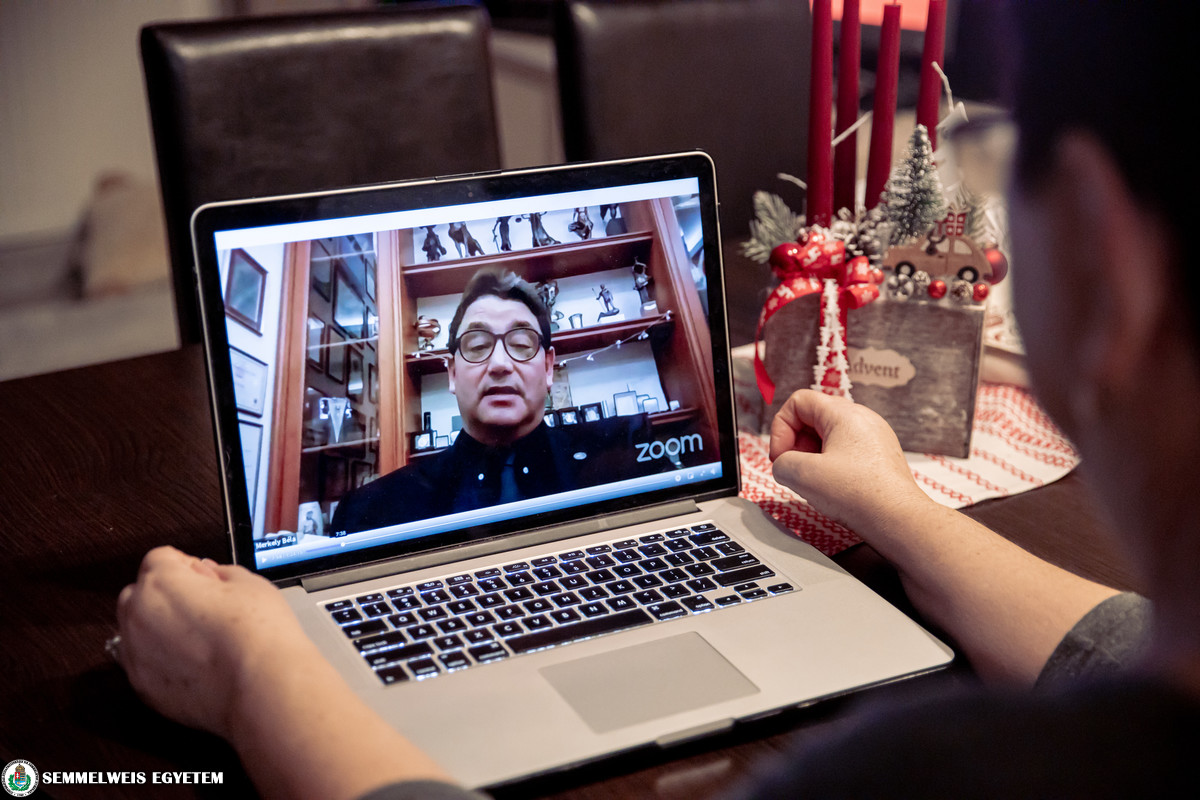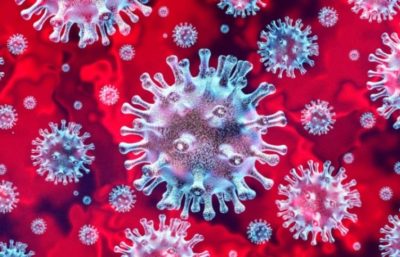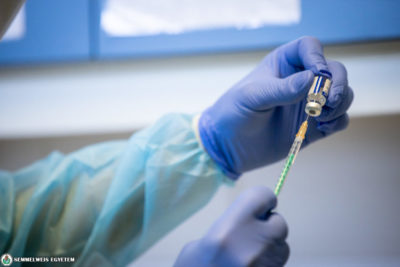In his online presentation entitled “Semmelweis mission”, Dr. Béla Merkely spoke about current epidemiological data and revealed that approximately 2 million Hungarian people may have been infected with the coronavirus in the second wave and the average age of the deceased is 77 years. He considers the restrictive measures introduced a month ago effective, since the epidemic has hit plateau and the numbers are improving, yet mortality rate has increased among th eelderly. In his presentation, the rector introduced the university, recalled the national representative COVID-19 screening survey, H-UNCOVER in May noting that a similar survey might be necessary in the course of the second wave as well, before the introduction of the national vaccination program.
“The 250-year-old history of Semmelweis University defines the direction even in the course of this special pandemic situation, which has to be followed by a rector as the leader of the institution”, said Dr. Béla Merkely in his presentation held at the online event organized by the Belgian Club of Hungarian Scientists.
Dr. Merkely also added that the university has served the country in the past quarter of a millenium as well in the areas of education, research and health care. He briefly introduced Semmelweis University by emphasizing that nearly 35% of the more than 11,000 students are international; education is conducted at six faculties in three languages; the ratio of teachers and students is 9:1, which is considered to be outstanding in the region; 4,500 medical doctors and health care professionals as well as more than 8,500 employees work here; the number of research groups is above 300; and 2.5 million medical cases are taken care of at the clinics per year.
“Semmelweis University belongs to the most prestigious higher education institutions in the world, it is now listed among the top 250 in the recently published Times Higher Education ranking in the area of health sciences, improving its previous ranking by 87 places. Semmelweis University can be found among the top 50 in Europe regarding education, and is among the top 3 regarding life sciences”, the rector highlighted.
Dr. Béla Merkely elaborated on the role the university played in the past in such historic events as the Revolution of 1848, World War I and World War II, as well as the Revolution of 1956. Maria Theresa added a medical faculty to the University of Trnava in 1769, and year later, exactly 250 years ago medical education began at the institution’s legal predecessor.
“The academic year of 2020/2021 is an anniversary year, full of challenges”, the rector pointed out.
He presented the role of Semmelweis University in the fight against coronavirus. Currently there is a global pandemic all over the world, which is caused by the Janus-faced features of COVID-19: the virus is extremely infectious, especially in enclosed spaces and in case of close proximity; without restrictive measures, a patient may infect 2.7 additional people on average – the rector emphasized. Dr. Merkely also demonstrated how the spread of the virus can be contained, also how the first wave in spring as well as the second wave in the autumn turned out. Semmelweis University was the first to prepare for the exceptional situation with ordering a significant amount of medical and protective equipment; also the institution has been a member of a working group focusing on the analysis of the epidemic since March together with several other Hungarian institutions providing medical training; the working group has already prepared more than 260 analyses about the coronavirus and the experts have consultations on a daily basis – the rector said.
 Dr. Béla Merkely talked about H-UNCOVER, a representative cross-sectional nationwide coronavirus screening survey led by Semmelweis University and carried out with the participation of the four medical universities of Hungary. The survey was organized by the Central Bureau of Statistics and was supported by The Ministry of Innovation and Technology. As the rector pointed out, the results of this survey defined the country’s exit-strategy on relaxing the restrictive measures introduced in the course of the first wave. The survey provided significant data for the medical specialists: it turned out that the likelihood of being infected is higher in the case of those patients who have hypertension, a cardiac disease, and chronic pulmonary-, renal- or hepatic disorders. It was also proven that COVID-19 is different from other infections of the upper respiratory track, since its typical symptoms are the loss of smell and taste as well as muscle pain occurring in various parts of the body – said Dr. Merkely. He also highlighted that H-UNCOVER was the first representative national screening survey in the world that focused on actively infected patients and patients who already recovered from COVID-19 at the same time.
Dr. Béla Merkely talked about H-UNCOVER, a representative cross-sectional nationwide coronavirus screening survey led by Semmelweis University and carried out with the participation of the four medical universities of Hungary. The survey was organized by the Central Bureau of Statistics and was supported by The Ministry of Innovation and Technology. As the rector pointed out, the results of this survey defined the country’s exit-strategy on relaxing the restrictive measures introduced in the course of the first wave. The survey provided significant data for the medical specialists: it turned out that the likelihood of being infected is higher in the case of those patients who have hypertension, a cardiac disease, and chronic pulmonary-, renal- or hepatic disorders. It was also proven that COVID-19 is different from other infections of the upper respiratory track, since its typical symptoms are the loss of smell and taste as well as muscle pain occurring in various parts of the body – said Dr. Merkely. He also highlighted that H-UNCOVER was the first representative national screening survey in the world that focused on actively infected patients and patients who already recovered from COVID-19 at the same time.
“Universities not only take part in the analysis of the pandemic, but also in diagnostics and in patient care”, emphasized the rector.
He also pointed out that nearly 40% of the positive COVID-19 cases are idetified by the screening procedures performed by the national medical universities. Based on the data, the restrictive measures turned out to be efficient, since the epidemic has hit plateau and the number of hospitalized patients and patients on ventilator is not increasing. However, in the case of patients above the age of 80, the numbers are increasing because of higher risk factors; the average age of the deceased is 77 years . Dr. Merkely considered the restrictive measures introduced by the government in November of utmost importance, since the capacity of the Hungarian health care system is 1,000 ventilated patients. This amount or more patients in serious conditions cannot be handled by the health care system in the long run. On the basis of estimations, the number of COVID-19 cases was around 56,000 during the first wave of the epidemic, yet in the course of the second wave, approximately 2 million Hungarian people may have been infected with coronavirus, many of them may have recovered from the disease without any symptoms. According to Dr. Merkely, before launching the national vaccination program, there is a need for a representative survey focusing on the current level of infection to determine the vaccination strategy as well.
Semmelweis University must carry on with its responsibilities, even in the course of the pandemic: based on its three-pillar mission, education, research-innovation and health care have to be continued – the rector pointed out.
“Education is carried out in a so-called hybrid form, according to which practical training sessions and seminars with a small number of students are held in person and lectures of larger audiedces are held online. Research is not only continued, but several scientific collaborations and publications focusing on COVID-19 have emerged: for example studies examining the properties of the virus and therapeutic opportunities, as well as achievements such as a ventilator designed specifically for patients suffering from coronavirus, developed by the university’s medical professional leadership. In patient care, so far 1,400 COVID-19 inpatients and 15,000 outpatients have been treated at the university departments; the institution reacted rapidly to the epidemic by taking immediate measures: ethic guidelines were introduced to employees and students; patients recovered from coronavirus were invited to participate in plasma donation; in the course of the increasing number of cases of the neighbouring countries, the mandatory and free PCR testing was ordered for employees of the university returning from abroad starting from July. The students of the university take part in the fight against coronavirus starting from the very beginning: besides providing support in the university’s screening procedures, students also participate in the PCR testing procedures organized and performed by the National Ambulance Service, also more than 150 volunteering students took part in the screenings performed in Slovakia. Semmelweis University was responsible for ensuring that the epidemiological protocol was followed at several international sport events organized in Hungary, such as the Formula-1 Hungarian Grand Prix and the event of the International Swimming League”, Dr. Merkely said.
Among the Hungarian higher education institutions, Semmelweis University was the first to start raising students’ and people’s awareness related to coronavirus and was the first to prepare COVID-19 online information pages, where an instruction video is available on proper hand washing and guidelines can be read regarding how to prepare a textile facial mask. The most-read articles of the web page of the university in 2020 are all related to COVID-19: the most clicked article was the one about introducing the role of BCG vaccination in the fight against COVID-19, this is followed by the guidelines focusing on how to support our relatives suffering from COVID-19 at home, and the public information about the virus. The university as well as its employees appeared in altogether 6,855 press releases related to coronavirus. The information appearing on the website of Semmelweis University reached out to several hundred thousands of people, and authentic communication is especially important in a pandemic situation.
“Infections going beyond the boundaries can only be conquered with a global cooperation. No country will be safe until everybody is safe”, the rector quoted the words of Dr. Zsuzsanna Jakab, Deputy Director-General of WHO as the closing of his presentation.
Ádám Szabó
Photo: Attila Kovács – Semmelweis University
Translation: Katalin Illés-Romhányi


